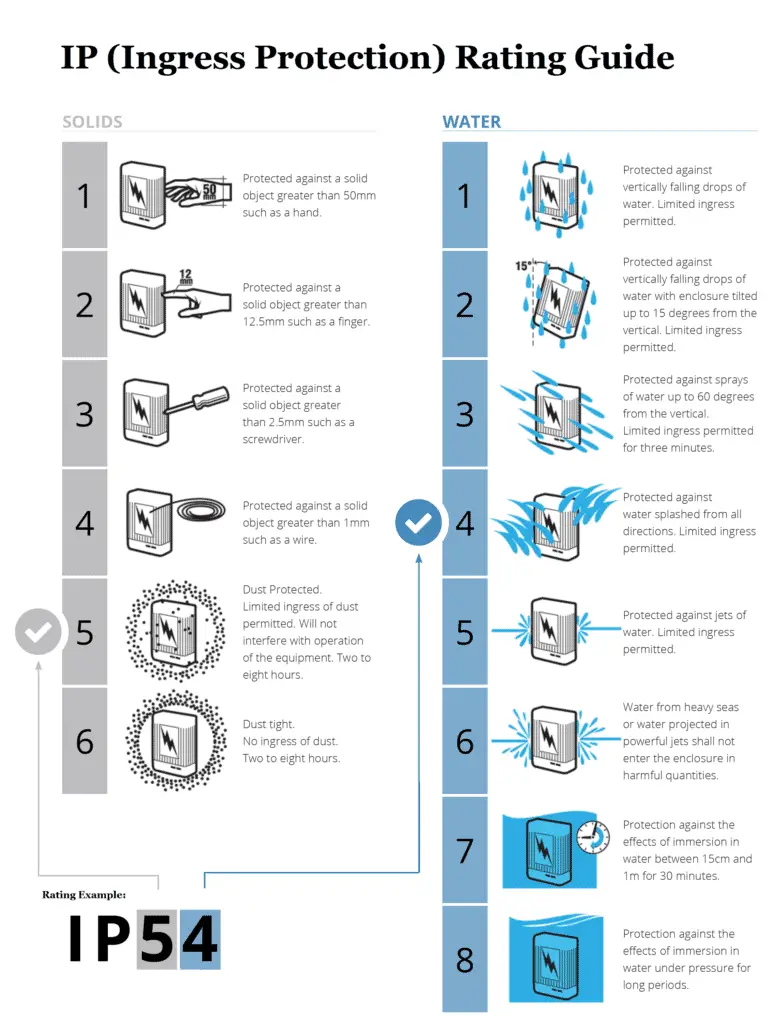Electrical and electronic devices are prone to get damaged by the intrusion of any solids or liquids. Over the years, technological innovations have led to the development of many ways to protect those devices from foreign objects and liquids.
But as a consumer how do you know if my device is projected from dust and water?
That is where IP ratings or Ingress Protection ratings come into the picture.
IP Ratings is an international standard to rate or grade electrical or electronic devices on the level of projection they carry. The higher the rating, the higher the level of protection. Let’s learn more about IP Ratings here in this article.
What Is IP Ratings For Batteries
IP Ratings (Ingress Protection) is a standard that defines how good batteries are against solid objects and liquids. Understanding IP Ratings is crucial when choosing batteries for different applications, as it indicates the level of protection the batteries offer against environmental factors.
What Are IP Ratings?
IP Ratings, also known as Ingress Protection ratings, are defined by the international standard EN 60529. The first edition of IEC 60529 was published in 1976 to create a single document to bring together all requirements regarding protection by enclosures.
These ratings are used to specify the degree of protection provided by an electrical enclosure against the intrusion of foreign bodies such as dust and water. The purpose of IP Ratings is to provide users with clear information about the level of protection a device or equipment offers against environmental elements.
The IP Rating system consists of two digits. The first digit indicates the level of protection against solid objects, while the second digit indicates the level of protection against liquids.
The Significance of IP Ratings for Batteries
IP Ratings are essential for understanding a battery’s resistance to solid objects and liquids. For example, a battery with a high IP Rating is more suitable for outdoor use where it may be exposed to dust, dirt, or water. In industrial settings, where batteries may encounter harsh conditions, IP Ratings play a crucial role in ensuring the longevity and reliability of the batteries.
Decoding the IP Rating System
Understanding the first digit: protection against solid objects
The first digit in an IP Rating ranges from 0 to 6 and indicates the level of protection against solid objects. A rating of 0 means no protection, while a rating of 6 indicates complete protection against dust and other solid particles.
Understanding the second digit: protection against liquids
The second digit in an IP Rating ranges from 0 to 8 and indicates the level of protection against liquids. A rating of 0 means no protection, while a rating of 8 indicates protection against continuous immersion in water under specified conditions.
IP Ratings Chart

Interpreting IP Ratings for Batteries
When selecting batteries for specific applications, it’s important to interpret the IP Ratings to ensure that the chosen batteries can withstand the environmental conditions they will be exposed to. For instance, a battery with an IP Rating of IP67 would be suitable for outdoor use as it offers complete protection against dust and can withstand immersion in water up to a certain depth.
Conclusion: IP Ratings ( Ingress Protection)
Understanding IP Ratings is crucial when choosing batteries for different applications. The ratings provide valuable information about a battery’s resistance to solid objects and liquids, ultimately ensuring the durability and reliability of the batteries. By interpreting IP Ratings correctly, users can make informed decisions and select batteries that meet the specific environmental requirements of their applications.
